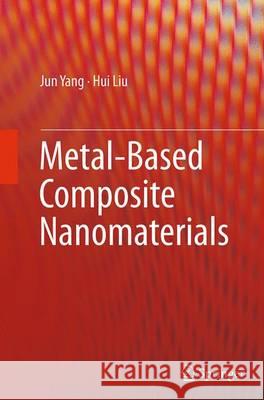Metal-Based Composite Nanomaterials » książka



Metal-Based Composite Nanomaterials
ISBN-13: 9783319356518 / Angielski / Miękka / 2016 / 259 str.
This book introduces the latest research developments in composite nanomaterials and summarizes the fundamentals and technical approaches in synthesis, fabrication and processing of composite nanomaterials.
Preface 1 Introduction References 2 A General Phase Transfer Approach for Metal Ions and Nanoparticles 2.1 Foreword 2.2 Brust-Schiffrin method 2.3 Ethanol mediated phase transfer 2.3.1 Ethanol mediated phase transfer of metal precursors 2.3.2 Ethanol mediated phase transfer of metal nanoparticles already formed 2.4 Summary References 3 Nanocomposites of Gold and Semiconductors 3.1 Foreword 3.2 A general synthetic approach for semiconductor nanocrystals 3.3 Deposition of Au on the surface of semiconductor nanocrystals 3.3.1 Contributions from the Banin group 3.3.2 Contributions from the other research groups 3.3.3 Semiconductor-gold nanocomposites based on the general phase transfer protocol 3.3.3.1 Semiconducting metal sulfide nanocrystals 3.3.3.2 CdS-Au nanocomposites 3.3.3.3 Metal sulfide-Au nanocomposites 3.3.3.4 PbS-Ag/Au nanocomposites 3.4 Deposition of other noble metals on the surface of semiconductor nanocrystals 3.5 Semiconductor–gold nanocomposite catalysts for the efficient three-component coupling of aldehyde, amine and alkyne in water 3.6 Summary References 4 Nanocomposites Consisting of Silver Sulfide and Noble Metals 4.1 Foreword 4.2 Aqueous synthesis of Ag2S nanocrystals 4.3 Binary Ag2S-noble metal nanocomposites 4.4 Multiple Ag2S-noble metal nanocomposites 4.5 Electrochemical property of Pt-containing Ag2S-noble metal nanocomposites 4.6 Summary References 5 Cadmium Selenide-Platinum Nanocomposites with A Core-Shell Construction 5.1 Foreword 5.2 Reversible phase transfer of semiconductor and noble metal nanoparticles 5.2.1 Ligand exchange-based phase transfer of semiconductor and noble metal nanoparticles from organic medium to aqueous phase5.2.2 Electrostatic interaction -based reversible phase transfer of semiconductor and noble metal nanoparticles between organic medium and aqueous phase 5.3 Core-shell CdSe@Pt nanocomposites 5.3.1 Characterizations of CdSe nanocrystals and core-shell CdSe@Pt nanocomposites 5.3.2 The compressive strain effect of CdSe core on Pt shell 5.3.3 Electrochemical activity of core-shell CdSe@Pt nanocomposites 5.4 Summary References 6 Nanocomposites of Silver Sulfide and Noble Metals with Controlled Nanostructures 6.1 Foreword 6.2 Inside-out diffusion of Ag in Ag-containing single or double shell core-shell metal nanoparticles 6.3 Nanocomposites consisting of Ag2S and noble metal nanoparticles with hollow interiors 6.4 Nanocomposites consisting of Ag2S and bimetallic Au-Pt nanoparticles with cage-bell structures 6.5 Core-shell Pd-Ag2S nanocomposites 6.6 Ternary nanocomposites consisting of Ag2S, Au, and Pt nanoparticles with hollow interiors 6.7 Electrochemical properties of the nanocomposites and their core-shell parents 6.8 Summary References 7 Nanocomposites of Metal Oxides and Noble Metals 7.1 Foreword 7.2 Novel gold catalysts for the oxidation of CO at low temperature the pioneering work by Haruta et al. 7.3 Early studies in metal oxide-Au nanocomposites 7.4 Dumbbell-like metal oxide-noble metal nanocomposites 7.5 High-order nanocomposites 7.6 RuO2-based nanocomposites 7.6.1 RuO2/C nanocomposites 7.6.2 RuO2-Au/C nanocomposites 7.6.3 Electrochemical properties of RuO2/C and RuO2-Au/C nanocomposites 7.7 Summary References 8 Nanocomposite-Related Scientific Issues 8.1 Foreword 8.2 Room temperature synthesis and growth mechanism of Ag2S nanocrystals in a nonpolar organic solvent 8.2.1 Formation of monodisperse Ag2S NCs in toluene at room temperature 8.2.2 Structural evolutions of Ag2S nanocrystals 8.2.3 Growth mechanism of Ag2S nanocrystals 8.2.4 Influence of temperature and Ag/S molar ratios on the growth of Ag2S NCs 8.2.5 Synthesis of dimeric Ag2S-Au nanocomposites 8.3 Diffusion of gold from the inner core to the surface of Ag2S nanocrystals 8.4 Coalescence of Ag2S and Au nanocrystals at room temperature 8.4.1 Coalescence of Au and Ag2S nanocrystals 8.4.2 Mechanism accounting for the coalescence of Au and Ag2S nanocrystals 8.4.3 Removal of Au from quantum dot-Au hybrids 8.4.4 Extraction of Au from Au-containing alloy nanoparticles 8.5 A facile solution route for the synthesis of PbSe–Au nanocomposites with different morphologies 8.5.1 Synthesis of PbSe seed particles 8.5.2 Synthesis of PbSe-Au nanocomposite 8.5.3 Mechanism for the nucleation and growth of Au on PbSe nanocrystals 8.6 Selective electrocatalysts toward a prototype of the membraneless direct methanol fuel cell 8.6.1 Ternary Au@Ag2S-Pt nanocomposites as selective electrocatalysts at DMFC anode 8.6.2 CBS Pt-Ru nanoparticles as selective electrocatalysts at DMFC cathode 8.6.3 A prototype of the membraneless direct methanol fuel cell 8.7 Summary References 9 Conclusion and Perspectives.
Prof. Jun YANG was born in Hebei, China, in 1972. He received his Ph.D. in Chemical and Biomolecular Engineering in 2006 from National University of Singapore (with Professor Jim Yang LEE). After postdoctoral research at Boston College and University of Toronto, he joined the Institute of Bioengineering and Nanotechnology, Singapore in 2007. In 2010, he moved to Institute of Process Engineering, Chinese Academy of Sciences as the leader of Group of Materials for Energy Conversion and Environmental Remediation (MECER). His main research interests include (i) applied catalysis, (ii) nanocomposites for energy conversion, (iii) synthesis and application of novel nanocrystalline materials, and (iv) separation techniques.
Dr. Hui LIU was born in Shandong, China, in 1986. She studied environmental engineering at South-Central University for Nationalities (B.S. 2008) and organic chemistry at University of Science and Technology Beijing (M.S. 2010). She received her Ph.D. with Prof. Jun YANG at Institute of Process Engineering, Chinese Academy of Sciences (IPE-CAS) in 2014 and started as an Assistant Professor of Group of Materials for Energy Conversion and Environmental Remediation (MECER) at IPE-CAS at the same year. Her research interests focus on the synthesis of novel composite nanomaterials for energy conversion and environmental remediation, electrocatalysis, and Phase transfer-based extraction of heavy metals.
This book introduces the latest research developments in composite nanomaterials and summarizes the fundamentals and technical approaches in synthesis, fabrication and processing of composite nanomaterials. The author describes the intrinsic relationship between the catalytic properties and the physical and chemical effects in the composite materials, providing for theoretical and technical bases for effectively developing novel electrocatalyts - applications of the nanocomposites in energy conversion areas.
1997-2026 DolnySlask.com Agencja Internetowa
KrainaKsiazek.PL - Księgarnia Internetowa









